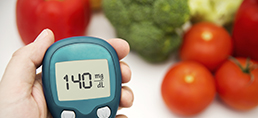
If your Christmas tree isn’t in balance, it will topple to the floor.
Same goes for your diet and its effect on your well-being. Unfortunately, the center of nutritional gravity is even more critical if you’re battling diabetes.
It’s tough, no doubt. While your friends graze gregariously at the holiday buffet, loading their plates with cookies, sweet breads, cream-cheese dips and tangy meatballs, you’re relegated to a few broccoli florets and carrot sticks.
Ba humbug on the ho-ho-whole plate.
If you’re one of the estimated 100 million people in the United States with diabetes or prediabetes, monitoring your blood sugar levels is crucial to maintaining your overall health and wellness.
Feeling hopeless and left out of all the scrumptious Santa snacks this time of year?
There’s still a way to get your jolly on, according to Lynn DeWitt, a registered dietitian who offers classes through the Spectrum Health Center for Diabetes Education.
“People with diabetes can live better if they learn more,” DeWitt said.
In other words, if you make good choices, you can still enjoy the holidays.
“There are many good food and lifestyle choices out there,” DeWitt said.
Enjoy life with a strategy
The key is to balance carbohydrates, fat and fiber in your diet, according to DeWitt.
“Watch for high-fiber foods because these help blood sugar behave better by metabolizing more slowly,” she said. “The longer the body takes to assimilate what we eat into glucose, the better. Fiber slows down that process, which is important for people with diabetes.”
Watching your carbohydrates is critical.
The American Diabetes Association recommends that 50 to 60 percent of total daily calorie intake should be in the form of carbohydrates. But once digested, carbohydrates metabolize into glucose (sugar).
Eyeing that dessert table at the other end of the room? That’s likely where most of the carbs are lurking.
Reaching for the stuffing with a full-sized serving spoon? Pull back on those reindeer reins and refrain. The average serving of homemade stuffing packs 30 grams of carbohydrates.
You don’t have to do without, but DeWitt suggests filling up first on the roasted turkey, salads and vegetables, then treat yourself to a small dab of stuffing.
“If this is your one-and-only chance all year to have Aunt Betty’s homemade casserole, plan for it and balance out your choices,” DeWitt said.
For example, forego a roll and dessert in exchange for a serving of that casserole.
What if you give into temptation and overindulge? Don’t panic. You’re the boss of your blood sugar and you have the power to control it.
Step away from the table and take a walk. Exercise helps lower blood sugar levels.
Don’t forget to check your glucose level two hours after you eat. It takes about that long for levels to return to near normal.
DeWitt’s other “sweet holiday” hints:
• If you’re eating at someone’s home, bring a dish you know you can eat safely.
• Don’t arrive at an event hungry. You’ll be tempted to overeat.
• If you want to celebrate with a cocktail—and if your physician allows you to have alcohol—use a sugar-free drink mix or choose the drier wines, such as chardonnay or sauvignon blanc.
• Spoon up small serving sizes and savor your food. Even a taste is better than missing out completely.
• Use smaller dishes or bowls so you can fool your eyes into thinking you are eating larger portions.
• If you’re the host, send tempting leftovers home with guests.
 /a>
/a>
 /a>
/a>
 /a>
/a>